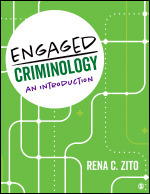You are in: Central America
Change location
You are here
Engaged Learning Techniques in Criminology
EFFECTIVE IDEAS FOR YOUR COURSE
Techniques for Engaged Learning in the Criminology Classroom
By Rena C. Zito, associate professor of Sociology, coordinator of the Criminal Justice Studies program at Elon University, and author of Engaged Criminology: An Introduction

Any half-awake professor has noticed that today’s college students are struggling. It’s no surprise that many are anxious, exhausted, and disengaged after their formative years were disrupted by a global pandemic and remote learning. The Chronicle of Higher Education dubbed it the “student-disengagement crisis” in 2022.
While no one instructor can single-handedly combat widespread cultural malaise, we can design our courses to foster engagement, motivation, and buy-in. Perhaps no course is more well-positioned to do this than Criminology.
Whether you are teaching a 30-student in-person seminar or a 150-person online section, these strategies are designed to get your students interested in criminology by drawing out and working with pre-existing ideas, providing creative alternatives to stale and AI-vulnerable assignments, and getting them doing criminology.
Engage with connection
If disengagement is the problem, then connection is the solution. Invite students to be part of a community of learners using strategies that draw out student viewpoints and get them interacting in low-stakes activities.
- Take-a-stand activities: Have students take a position in response to a story or prompt. For in-person classes, you can have them stand up and create a human histogram of responses. However, anonymous scores of 1 to 10 are best for honest reactions.
- Role play activities: Perspective taking fosters empathy and reflection. Assign roles (e.g., perpetrator’s mother, judge, victim, neighbor, employer) to explore multiple perspectives on complex criminal justice issues.
- Think-pair-share: Engage quiet and contemplative students in your discussions of policies, programs, and explanations in a three step process: (1) free write on their own, (2) discussion with a neighbor, and then (3) large-group discussion.
Engage with data
I’m willing to wager that the list of learning objectives in your syllabus includes something about using data. Move beyond familiarity with the Crime Data Explorer using these strategies.
- Beginning-of-semester surveying: Find out what your students are coming into your courses knowing and thinking about crime and punishment. Use the results of the survey throughout the semester.
- Myth-busting using data: Assess students’ or their peers’ knowledge of crime using official crime data and victimization survey data. Explore reasons for and consequences of misperceptions.
- Students as field researchers: Courtroom observations are an ideal way to engage students as researchers and expose them to the realities of the criminal legal system.
Engage with innovative genre
Ask yourself: What is my goal for this assignment? If the answer is something like “I want them to demonstrate understanding of deterrence concepts” or “I want them to think critically about bail reform,” then there are better, more creative options for achieving those goals than the traditional course paper.
- Concept photography: Taking original photos is a fun and creative way for students to demonstrate their learning of criminological concepts. Incentivize quality work by hosting a “photography exhibit.”
- Letters to the editor: We want our students to be engaged citizens, not just engaged learners. Require or encourage students to submit their evidence-based letters.
- Podcasts: Free podcasting apps like Spotify for Podcasters allow even beginners to create high-quality edited episodes on pressing criminal justice issues. Their sources can go in time-stamped show notes.
References / Additional Reading
“How to Solve the Student-Disengagement Crisis: Six Experts Diagnose the Problem — and Suggest Ways to Fix It.” The Chronicle of Higher Education, The Chronicle of Higher Education, 11 May 2022, www.chronicle.com/article/how-to-solve-the-student-disengagement-crisis.

